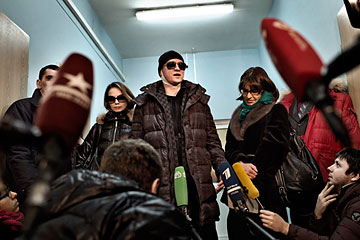
Filin leaves the hospital on Feb. 4. He has introduced contemporary productions to the Bolshoi repertoire
The snow was coming down in big, shimmery clumps on the night of Jan. 17, when Sergei Filin, the artistic director of the Bolshoi Ballet, drove to his apartment building in the center of Moscow just before midnight. He was returning home from a gala attended by the city's theatrical elite. After parking near the gate of his building, he was punching in its security code when he sensed someone standing behind him. He turned to find a man whose face was covered with a scarf or mask. Before Filin could turn away, the man splashed a jar of sulfuric acid--a compound widely sold for cleaning sewers; it is so corrosive to human flesh that in the Middle Ages it was known as "the oil of vitriol"--upward into his face. Gasping from shock, Filin dropped to the ground, not seeing which way the assailant had run, and began rubbing fistfuls of snow into his eyes, half to wash them out, half to dull what he later described in television interviews as "inexpressible pain." The acid was burning into his scalp, through the surface of his eyes and the skin of his handsome face.
News of the attack spread within hours through the troupe of the world's most storied ballet company, and by mid-morning waiflike dancers bundled up in heavy coats began plodding up to the burn ward of Moscow's Hospital No. 36, some clutching bouquets of flowers. No one was allowed to see Filin except his wife and his mother. So his friends assembled for a grim vigil in the waiting room downstairs, where whispered grief was interspersed with theories of who could be culpable--a scorned lover, a business partner, a rival at the theater, an unhinged ballet fanatic or some combination of suspects. It was a testament to how troubled the Bolshoi has become that every theory seemed plausible amid the intrigues plaguing the theater. One of the young women in the waiting room that day looked down at her feet, which were splayed into a V from years at the barre, and wondered aloud, "What have we become?"
It is a question that has concerned many Russians in the past month--even cabdrivers bemoaned the attack to me--as they were again confronted with the sorry state of the theater's image and, as many felt by association, that of the country. In Russia there is no cultural institution more central to the national sense of self than the Bolshoi, which has outlasted both the czars and the Communists. For 236 years it has been "a mirror reflecting all the turmoil in the country." This was how Anatoly Iksanov, the Bolshoi's general director, described it to me in the fall of 2011, a few weeks before the theater reopened after a major renovation.
It had taken six years (almost twice as long as planned) and, according to a state-run government watchdog called the Audit Chamber, cost the Kremlin over a billion dollars (16 times the original projected budget) to reconstruct the crumbling theater, all with the aim of restoring it as the face of the nation. That aim was achieved, but probably not in the way the Kremlin intended. Despite the theater's immaculate facade and balconies dripping with gold, many ills of Russian society--the ruthless ambition, the clan rivalries and the politics--have warped the public face of the Bolshoi. "The jar of acid was just the culmination," Iksanov told me recently.
